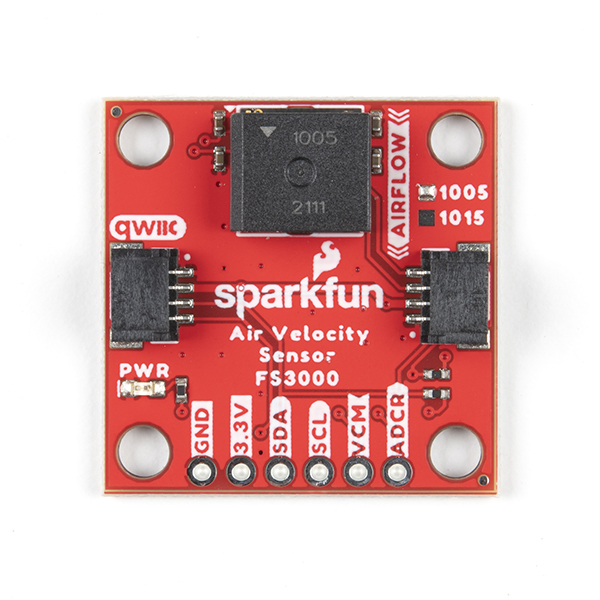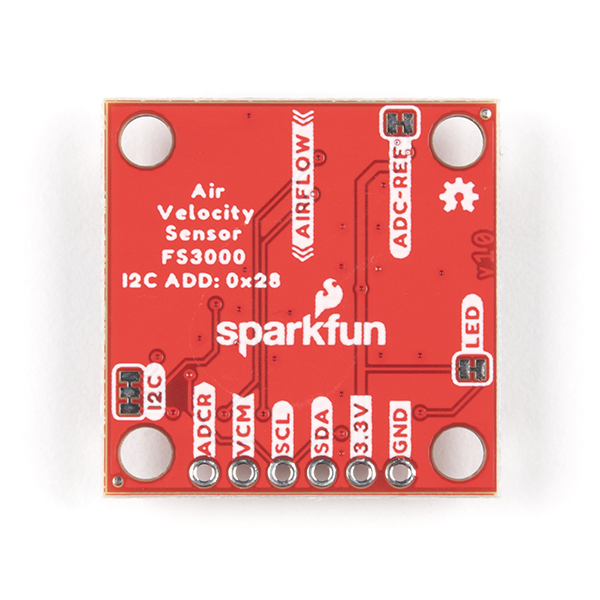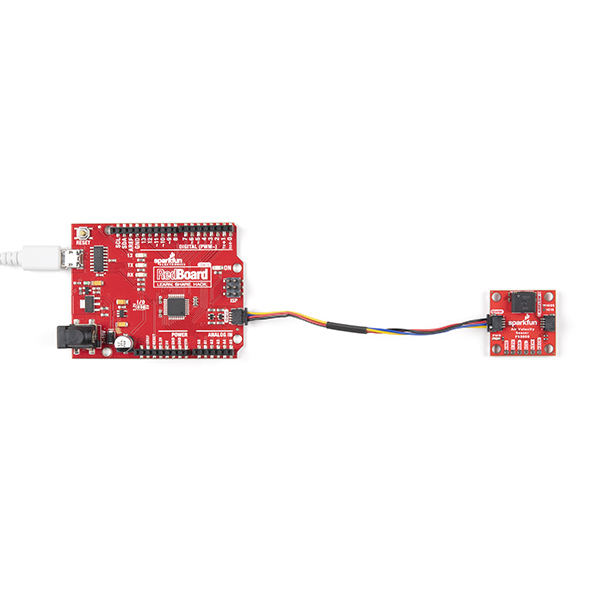SparkFun Air Velocity Sensor Breakout - FS3000-1005 (Qwiic)
Need to keep track of the airflow in your data center or around your servers? How about making sure your HVAC and air control systems are functioning at full capacity? Well, the new SparkFun FS3000-1005 Air Velocity Sensor Breakout can help you with all that and more! It's super easy and super quick (Qwiic!) to hook up.
This breakout board is focused around Renesas' FS3000-1005, a surface-mount air velocity module with a range of 0-7.2m/s (0-16.2mph). It utilizes a MEMS thermopile-based sensor, features a digital output with 12-bit resolution and comprises a “solid” thermal isolation technology and silicon carbide coating to protect it from abrasive wear and water condensation.
We've written an Arduino library to help you get started quickly. You can download the library through the Arduino library manager by searching 'SparkFun Air Velocity' or you can get the GitHub repo as a .zip file and install the library from there.
The SparkFun Qwiic Connect System is an ecosystem of I2C sensors, actuators, shields and cables that make prototyping faster and less prone to error. All Qwiic-enabled boards use a common 1mm pitch, 4-pin JST connector. This reduces the amount of required PCB space, and polarized connections mean you can’t hook it up wrong.
- I2C address: 0x28
- Air flow speed: 0 - 7.23 m/sec (0 - 16.17mph)
- Accuracy: 5% of full scale flow range
- Resolution: 12-bit
- Input Voltage: 2.7-3.3V
- Average current draw: 10mA
- 2x Qwiic Connectors
- PWR LED
- Jumpers
- LED
- I2C
- ADC-REF
- Board Dimensions: 1.00in. x 1.00in.
SparkFun Air Velocity Sensor Breakout - FS3000-1005 (Qwiic) Product Help and Resources
Air Velocity Sensor Breakout - FS3000 Hookup Guide
September 23, 2021
Get started with the Air Velocity Sensor Breakout - FS3000!
Core Skill: Programming
If a board needs code or communicates somehow, you're going to need to know how to program or interface with it. The programming skill is all about communication and code.
Skill Level: Competent - The toolchain for programming is a bit more complex and will examples may not be explicitly provided for you. You will be required to have a fundamental knowledge of programming and be required to provide your own code. You may need to modify existing libraries or code to work with your specific hardware. Sensor and hardware interfaces will be SPI or I2C.
See all skill levels
Core Skill: Electrical Prototyping
If it requires power, you need to know how much, what all the pins do, and how to hook it up. You may need to reference datasheets, schematics, and know the ins and outs of electronics.
Skill Level: Rookie - You may be required to know a bit more about the component, such as orientation, or how to hook it up, in addition to power requirements. You will need to understand polarized components.
See all skill levels
Comments
Looking for answers to technical questions?
We welcome your comments and suggestions below. However, if you are looking for solutions to technical questions please see our Technical Assistance page.
Customer Reviews
4 out of 5
Based on 1 ratings:
1 of 1 found this helpful:
Easy to setup and very responsive
It is a good device, it responds well, it complies with the described specifications and it is very easy to implement through i2c with the recommended libraries.






This would be awesome to have with the FS3000-1015 sensor, which goes up to 33.5 MPH. Any chance you guys could offer it both ways? The 15 mph chip FS3000-1005 can't measure speeds normally reached by bicycle. Headwind/tailwind is something I am interested in measuring with this sensor. Thanks
Hi Radiohound, Sounds like a cool project! Unfortunately, we don't have any immediate plans to sell the 1015 version. Could be something down the road, but how long I really can't say.
If you can rig up some sort of airflow intake system ahead of the sensor (that is smaller than the area of the sensor intake), you can read faster air velocities. Maybe a fun 3D printing project? However, this would take a bit of experimenting and data-intake to get accurate conversions.
FWW, during my prototype testing on this design, I put the sensor in various PVC pipe diameters with some known air velocity sources (created by thinner pipes hooked up to oxygen flow meters and compressed air) and the readings matched the planned conversions quite nicely.
Thank you Pete, great answer! I appreciate it.
Would you mind sharing if you do pursue that? That was my interest with this board as well!
Hello, We made a calibration of this device in a wind tunnel at the Swiss Metrology Institut. At 8 m/s, this device give 2.5 m/s, so quite wrong. The greater the speed, the greater the error.
Could this be used to find an answer to the age-old question; what is the airspeed velocity of an unladen swallow?
From the product description "what about figuring out how fast your RC airplane is going?". 15 mph just isn't very fast for an RC plane - at or near stall speed for quite a few. Even 33.5 mph isn't very fast. I second Radiohound's request for the 1005 chip that could handle most bike speeds - measure airspeed vs. ground speed as an aid to riding.
Thanks for your feedback. We will definitely consider the 1015 as a future project. It would be a drop in replacement on the PCB layout, and a minor addition to the Arduino Library, however, sourcing the modules (and all parts these days, really) is another challenge.
Also, I agree, most RC airplane's are flying much faster, and so it would most likely be only useful on thermal gliders and slow slope floaters (maybe some VTPR in lighter conditions, but even those could max it out on big dives). I've decided to remove that suggestion from the description for now. I might give this a try on my Ahi and report back.
I was very excited to see this sensor pop up on the Friday Product Showcase so I bought one to measure/monitor the airflow when a Qwiic relay-controlled fan is on. Unfortunately, I can't find any Python modules to support the FS3000. Any ideas on if there will be any Python support? Thanks!
Hi there Kraxner, Sorry, but due to the fact that this module does clock stretching, we won't be creating python/raspi support.
It doesn't have much (in terms of setup), so basically, you just take readings from it, and then convert that raw reading into m/s or mph.
If you wanted to create your own simple I2C read python example, then you might be able to use this by slowing down your clock speed way down (like 5KHz or even 1KHz). It looks like some people are able to use I2C peripheral boards that do clock stretching with python in this way. Sorry for the long winded response here without the best news, but hope this helps.
Hi Pete, Thank you for the quick response and appreciate the additional context. This will give me something to go hunting for to see if it's worth the effort. Take care.